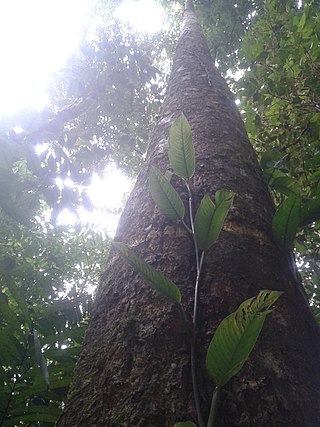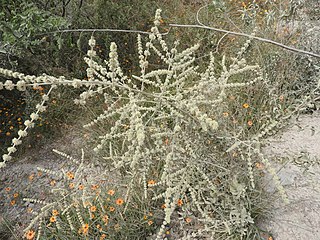
Coriaria is the sole genus in the family Coriariaceae, which was described by Linnaeus in 1753. It includes 14 species of small trees, shrubs and subshrubs, with a widespread but disjunct distribution across warm temperate regions of the world, occurring as far apart as the Mediterranean region, southern and eastern Asia, New Zealand, the Pacific Ocean islands, and Central and South America.

Grias is a genus of flowering plants in the family Lecythidaceae, described by Linnaeus in 1759. It is native to northwestern South America, Central America, and Jamaica.

Ugni is a genus of plants in the myrtle family Myrtaceae, described as a genus in 1848. It is native to western Latin America from the Valdivian temperate rain forests of southern Chile and adjacent regions of southern Argentina, north to southern Mexico.
Chamguava is a genus of the botanical family Myrtaceae, first described as a genus in 1991. It is native to southern Mexico and Central America.
- Chamguava gentlei(Lundell) Landrum - Chiapas, Belize, Guatemala, Honduras
- Chamguava musarum(Standl. & Steyerm.) Landrum - Guatemala
- Chamguava schippii(Standl.) Landrum - Guerrero, Chiapas, Belize, Guatemala, Panama

Pleodendron is a genus of plants in family Canellaceae described as a genus in 1899.
Prionosciadium bellii is a plant species endemic to the Mexican State of Michoacán. It occurs in brush areas at elevations of 1,800–2,100 m (5,900–6,900 ft).
Prionosciadium lilacinum is a plant species native to the Mexican States of Jalisco and Nayarit. It is common along sunlit roadsides and other disturbed habitats in the region.
Arracacia filipes is a plant species native to the Mexican State of Durango. It grows in moist, shaded areas in forests and canyons at elevations of 2,000–2,700 m (6,600–8,900 ft).
Arracacia macvaughii is a plant species native to the Mexican State of Querétaro. It is known only from the type locale, in a fir forest at an elevation of approximately 3100 m.
Eryngium jaliscense is a plant species native to the Mexican State of Jalisco. It grows in scattered populations in pine forests and other shaded slopes at elevations of 1,200–1,600 m (3,900–5,200 ft).
Trixis inula, the tropical threefold, is a plant species native to Texas, Mexico, Central America, northern South America, and the West Indies. It is found on open, sandy sites such as roadsides, thorn scrub, thickets, etc.

Celtis ehrenbergiana, called the desert hackberry or spiny hackberry, is a plant species that has long been called C. pallida by many authors, including in the "Flora of North America" database. It is native to Arizona, Florida, New Mexico and Texas, and to Latin America as far south as central Argentina. It grows in dry locations such as deserts, brushlands, canyons, mesas and grasslands.

Ardisia escallonioides, the Island marlberry, is a plant species native to the West Indies and neighboring areas. It has been reported from Barbados, Bermuda, the Dominican Republic, Cuba, Mexico, Belize, Guatemala and Florida.
Calycolpus warscewiczianus is a plant species native to Nicaragua, Costa Rica, Panamá and Venezuela.
Aristolochia stevensii is a plant species native to northwestern Nicaragua and southwestern Honduras. It grows in wet montane forests.
Cissus anisophylla is a plant species known from lowland rainforests of Panamá, Colombia, Chiapas, Brazil, Perú, Costa Rica and Ecuador.
Pinochia monteverdensis is a plant species native to Costa Rica, Guatemala and Oaxaca.

Bouvardia ternifolia, the firecracker bush, is a shrub widespread across much of Mexico, the range extending south into Honduras and north into the southwestern United States.

Asterohyptis is a genus of plants in the Lamiaceae, or mint family, first described in 1932. It is native to Mexico and Central America.
- Asterohyptis mocinoana(Benth.) Epling - widespread from Veracruz to Costa Rica
- Asterohyptis nayaranaB.L.Turner - Durango, Nayarit
- Asterohyptis seemannii(A.Gray) Epling - Chihuahua, Sonora, Sinaloa
- Asterohyptis stellulata(Benth.) Epling - from Sinaloa and Durango south to Honduras
Laxoplumeria is a genus of plants in the family Apocynaceae, first described as a genus in 1947. They are native to Panama and South America.







